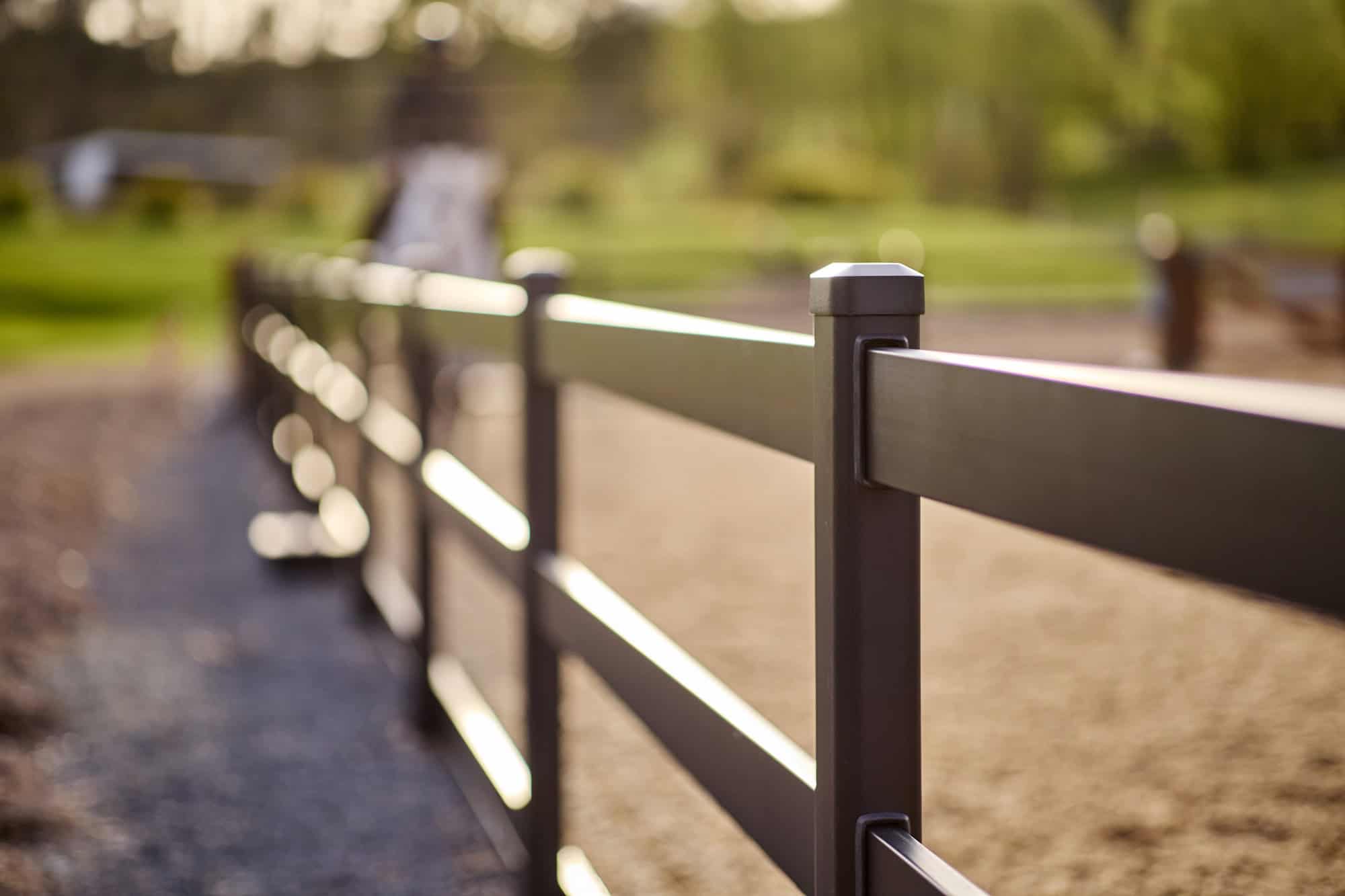Walk any ranch that’s been around a few decades and you’ll see it. That reddish-brown stain creeping up fence posts. Wire that’s gone brittle and weak. Metal that looked solid five years ago but now crumbles at the slightest pressure.
Rust doesn’t just make your fencing look bad. It makes it dangerous. Weakened wire breaks under pressure. Corroded posts fail when you need them most. And repair bills add up faster than you’d think, especially when you’re replacing the same sections every few years because you didn’t address the root problem the first time.
The promise of rust-resistant fencing sounds good. But not all rust resistance is created equal, and the difference between materials that truly resist corrosion and those that just delay it matters more than most ranchers realize.
What Is Rust-Resistant Fencing?
Rust-resistant fencing is any fencing system designed or treated to withstand oxidation and corrosion that occurs when metal is exposed to moisture and oxygen. The term covers a wide range of materials and coating systems, each with different levels of actual protection.
Rust resistance means the material either doesn’t rust naturally (like aluminum or stainless steel) or has been treated to prevent oxidation (like galvanized steel or powder-coated metals). The effectiveness of that resistance depends entirely on the specific material and treatment method used.
Basic galvanization dips steel in molten zinc to create a protective layer that sacrifices itself before the underlying steel corrodes. Hot-dip galvanization provides thicker coating than electroplating, offering significantly better protection. Powder coating adds another barrier, sealing the metal from moisture while providing color and UV protection.
The Cost of Rust on Ranch Properties
Rust isn’t just unsightly. It’s expensive, dangerous, and relentless. Once it starts, it spreads. What begins as surface discoloration becomes structural weakness that compromises your entire fencing system.
- Structural Failure: Rusted posts lose load-bearing capacity. What held strong under tension and impact when new gradually weakens until a determined horse or sudden wind load causes complete failure.
- Safety Hazards: Rust creates rough, jagged edges where smooth metal once existed. These sharp surfaces cause lacerations on livestock that lean or rub against fencing. Tetanus risk increases significantly with rust-related puncture wounds.
- Accelerating Deterioration: Rust spreads. Once the protective coating is breached at one point, moisture infiltrates and corrosion accelerates. A small rust spot this year becomes a major structural concern next year and complete failure the year after.
- Property Value Impact: Potential buyers notice rusted fencing immediately. It signals deferred maintenance and raises questions about what else hasn’t been maintained.
- Time Theft: Hours spent inspecting, repairing, and replacing rusted sections add up. Every weekend patching fence is a weekend not spent on what matters—your animals, your family, your operation.
Materials That Actually Resist Rust (and Those That Don’t)
Not all rust-resistant claims hold up when weather turns harsh and years pass. Here’s what actually works and what leaves you disappointed.
- Stainless Steel: The gold standard for rust resistance, but prohibitively expensive for large-scale fencing applications. Marine-grade stainless offers exceptional corrosion resistance but costs 3-5 times more than other options. Rarely practical for ranch fencing.
- Aluminum: Naturally rust-resistant because it oxidizes into a protective layer rather than destructive rust. However, aluminum lacks the structural strength needed for containing horses and large livestock. Works well for decorative applications but fails at the primary job of ranch fencing.
- Galvanized Steel: The workhorse of rust-resistant fencing. Hot-dip galvanization provides a thick zinc coating that protects underlying steel for 20-30 years in most climates. Quality varies, though—thicker galvanization equals longer protection. Look for G-90 or higher galvanization ratings.
- Galvanized + Powder Coated Steel: The ultimate combination for long-term rust resistance. Galvanization provides base protection while powder coating seals against moisture and UV damage. This dual-layer approach delivers 30-50 year lifespans in harsh environments. Our Steel Board fencing uses this system because it actually works.
- Vinyl-Coated Wire: Only rust-resistant until the vinyl cracks. And it will crack—from UV exposure, temperature cycles, and animal contact. Once compromised, the underlying wire rusts rapidly. The coating that was supposed to protect becomes a liability that traps moisture against the metal.
- Paint: Offers minimal rust protection and requires constant reapplication. Paint scratches, chips, and weathers quickly on ranch fencing.
- Cheap Electroplated “Galvanization”: Thin zinc coating applied electrically rather than through hot-dip process. Provides 3-5 years of protection at best. Often marketed as “galvanized” but performs nothing like hot-dip galvanization.
Climate Factors That Accelerate Rust
Your location determines how aggressively rust attacks your fencing. What works in Arizona might fail rapidly in coastal Georgia:
- Humidity: High humidity environments keep metal surfaces constantly damp, accelerating oxidation. Coastal properties and areas with heavy morning dew put extreme demands on rust resistance. Standard galvanization might suffice in dry climates but fails prematurely where humidity stays high.
- Salt Exposure: Coastal properties face the harshest rust conditions. Salt air aggressively attacks even quality galvanization. Only premium rust-resistant systems with dual-layer protection (galvanization plus powder coating) stand up to marine environments long-term.
- Freeze-Thaw Cycles: Northern climates create unique challenges. Water infiltrates microscopic coating imperfections, freezes, expands, and breaks protective layers from inside out. This cycle accelerates rust formation even on materials that perform well in stable climates.
- Industrial Pollution: Properties near industrial areas or heavy traffic experience accelerated corrosion from airborne pollutants. Sulfur compounds and other chemicals in the atmosphere chemically attack protective coatings faster than natural weathering alone.
- Irrigation and Sprinkler Systems: Well-intentioned irrigation that hits fencing creates constant wet-dry cycles that accelerate rust. Mineral content in well water leaves deposits that trap moisture against metal surfaces, creating perfect conditions for corrosion.
The rust resistance you need isn’t one-size-fits-all. It’s climate-specific. Properties in benign environments can use less aggressive rust protection. Harsh climates demand premium solutions. Trying to save money by under-specifying rust resistance for your climate is expensive false economy.
Why Buckley Steel Board Outperforms the Competition
We didn’t set out to create just another fence. We set out to solve the rust problem that plagues ranch fencing year after year.
Our Steel Board fencing starts with heavy-gauge steel—substantial enough to contain horses without the weakness that leads to premature failure. That steel gets hot-dip galvanized with zinc coating thick enough to measure. This isn’t the thin electroplating you find on budget options. It’s comprehensive protection that bonds molecularly to the underlying steel.
Then comes the powder coating—architectural grade, not the cheap stuff that cracks and peels within five years. This coating seals the galvanized steel from moisture, UV rays, and the constant abuse of ranch life. The combination creates a dual-barrier system where rust would need to breach both layers before reaching the steel itself.
That doesn’t happen. Not in ten years. Not in twenty. We’ve got installations pushing forty years still standing strong, still rust-free, still protecting livestock without complaint.
The engineering matters too. Our board design includes proper drainage channels that prevent water from pooling in contact points (those hidden spots where rust typically starts on inferior systems). Posts are designed to shed water rather than trap it. Every connection point considers how moisture might infiltrate and blocks those pathways.
Your property deserves fencing that holds up to whatever your climate throws at it. Fencing that’s still standing strong when it’s time to pass the ranch to the next generation. Fencing that doesn’t become a recurring expense and constant project.
When you’re ready to stop replacing rusted fencing and start protecting your property with materials built to last, give us a call. We’ll show you exactly what real rust resistance looks like and what it means for your operation’s future.
Frequently Asked Questions
Q. How long does galvanized steel fencing actually last before rusting?
Quality hot-dip galvanized steel typically provides 20-30 years of rust protection in moderate climates. Coastal or industrial environments may see reduced lifespans of 15-20 years. Adding powder coating extends protection to 30-50+ years regardless of climate conditions.
Q. Is aluminum fencing better than steel for rust resistance?
Aluminum won’t rust, but it lacks the structural strength needed for containing horses and large livestock. It bends easily under pressure and can’t withstand the forces ranch fencing must handle. For decorative applications, it’s fine. For working ranch fencing, properly protected steel is the better choice.
Q. Can I prevent rust on existing metal fencing?
Once rust starts, you can slow it but rarely stop it completely. Wire brushing to remove loose rust, then applying rust converter and protective coating can extend life temporarily. However, if corrosion has compromised structural integrity, replacement is the safer, more economical long-term solution.
Q. What’s the difference between galvanized and galvannealed steel?
Galvanized steel is coated with pure zinc through a hot-dip process. Galvannealed steel is heat-treated after galvanizing, creating a zinc-iron alloy layer. Galvannealed offers better paint adhesion but slightly less corrosion resistance than standard galvanized. For ranch fencing, hot-dip galvanized with powder coating provides optimal rust protection.
Q. Does powder coating prevent rust better than paint?
Yes, way better. Powder coating creates a thicker, more uniform barrier than paint and bonds better to the underlying metal. It doesn’t chip, crack, or peel like paint, maintaining its protective seal for decades. Paint requires frequent reapplication and offers minimal rust protection once scratched or weathered.



